
Image Source: http://wallpaperswa.com
“Scientific Notation”, (also referred to as “Standard Form”), is used by Scientists to represent very large numbers, like the Distance between stars and planets, in a much simpler form.
It is also used by Geographers and Economists to represent very large numbers such as how many square kilometers in area a Country is, and how big in millions its population is, or how many billions of dollars its current debt level is at.

Image Copyright 2013 by Passy’s World of Mathematics

Image Copyright 2013 by Passy’s World of Mathematics
Format of Scientific Notation
Scientific Notation always involves having a number that is between 1 and 10 multiplied by a Power of 10.
For example the distance from the earth to the sun is 149 600 000 km, and because this number is so big, it is usually listed in Scientific Notation.
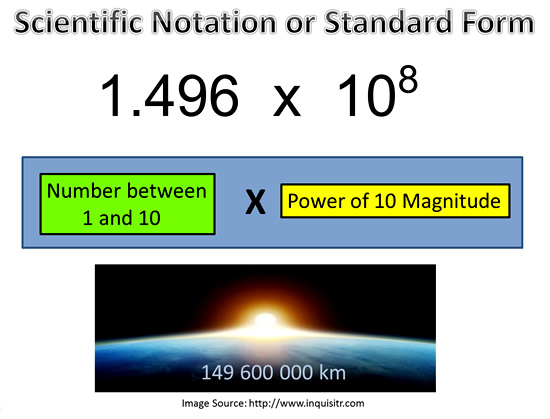
Image Copyright 2013 by Passy’s World of Mathematics
Helpful Tips for Dealing with Scientific Notation
Here are a couple of very useful tips to constantly keep in mind when doing any activities that involve Scientific Notation.
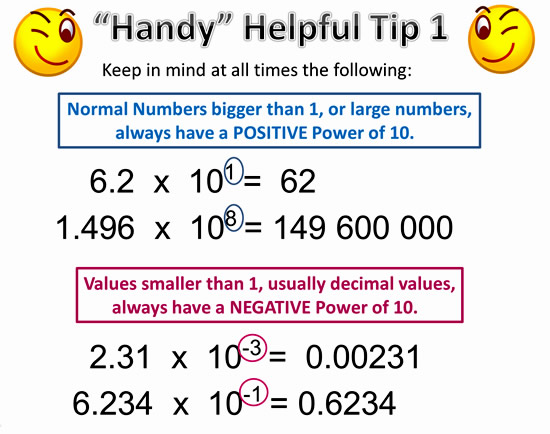
Image Copyright 2013 by Passy’s World of Mathematics
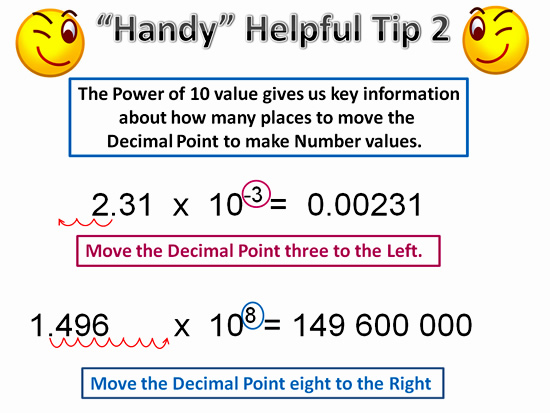
Image Copyright 2013 by Passy’s World of Mathematics
Videos About Scientific Notation
The following five minute video is an excellent explanation about why people use Scientific Notation.
Here is a quick video on how to convert Scientific Notation into a standard number value.
The following vidoe shows how to convert number values into Scientific Notation
Here is a quick video about how to write decimal values in Scientific Notation
Scientific Notation into Numbers
The following examples show how to convert Scientific Notation expressions into the actual numbers or decimals that they represent.
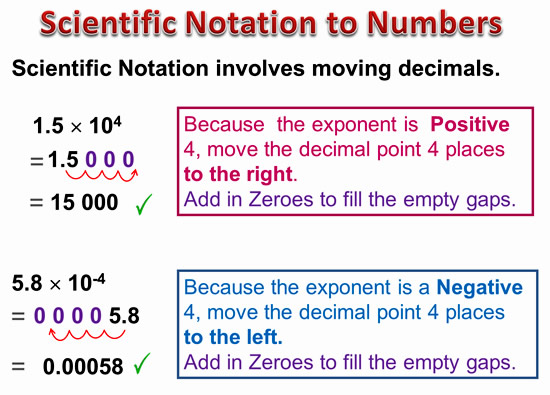
Image Copyright 2013 by Passy’s World of Mathematics
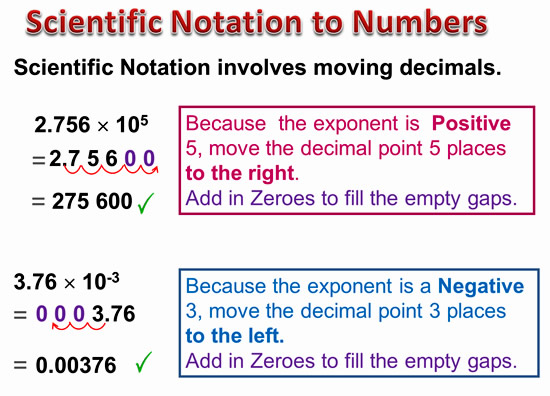
Image Copyright 2013 by Passy’s World of Mathematics
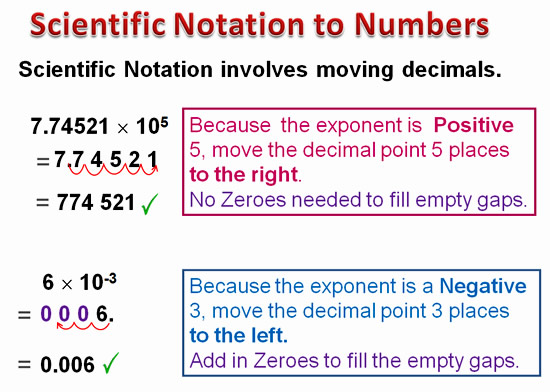
Image Copyright 2013 by Passy’s World of Mathematics
Numbers into Scientific Notation
Converting Numbers into Scientific Notation is a little bit trickier than doing Scientific Notation into Numbers.
However we should be okay if:
We follow the set sequence of steps, (shown in the examples below) and
Remember our key facts from the “Helpful Tips”:
Normal Numbers bigger than 1, or large numbers, always have a POSITIVE Power of 10.
Values smaller than 1, usually decimal values, always have a NEGATIVE Power of 10.
The first part of Scientific Notation is always a number value that is between 1 and 10. (eg. 1, 1.5, 2.3, 3.167, 4, 5.21, 6.3, 8.20, 9.9999 etc)
The second part of Scientific Notation is a Power of 10 which tells us how many places the decimal point is moving.
Here are some examples showing the full working out steps.

Image Copyright 2013 by Passy’s World of Mathematics
Because it can be easy to make little mistakes when converting into Scientific Notation, it is always an excellent idea to check our answers by working backwards and checking that our Scientific Notation does give us the back the original number or decimal that we started with.
It doesn’t take long to do this check, it is easy to do, and it guarantees us that we have the correct answer.
Here is how we can do a simple check for the example we just did above.
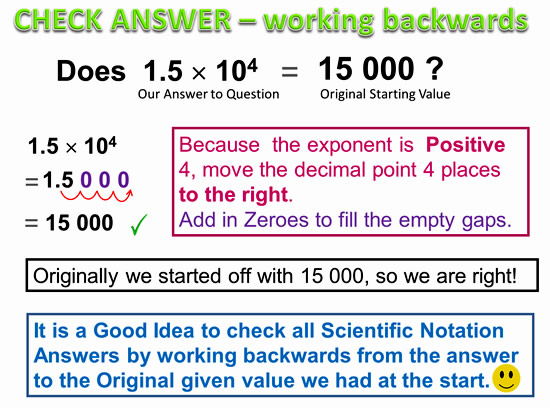
Image Copyright 2013 by Passy’s World of Mathematics
Here is an example showing how to convert a Decimal Value into Scientific Notation.
REMEMBER that Decimal Values always produce Negative Powers of 10.
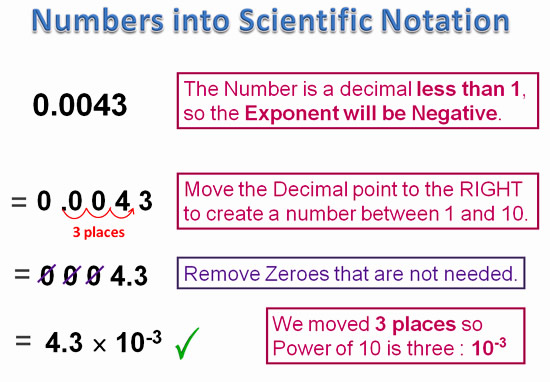
Image Copyright 2013 by Passy’s World of Mathematics
The following example shows a very important exception rule for removing zeroes from Decimal values that we are converting into Scientific Notation.
ANY ZERO THAT CAME AFTER THE DECIMAL POINT IN THE ORIGINAL STARTING DECIMAL NUMBER MUST NOT BE REMOVED.
The reason why is a little complicated, but works like this.
If somebody wrote down a measurement as 0.0050, this means they measured it to four decimal places to the nearest ten thousandth, and it is 50/10000.
If they had only measured it to three decimal places to the nearest thousandth, then the value would have been recorded as 0.005 and it is 5/1000.
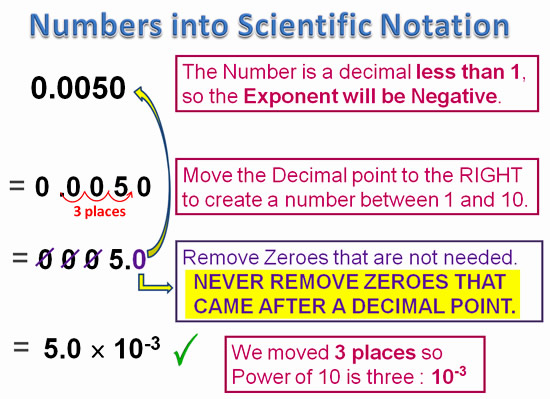
Image Copyright 2013 by Passy’s World of Mathematics
If we have a Power of 10 like 10, 100, 1000, 10 000 etc, we can convert it into Scientific Notation as shown below.
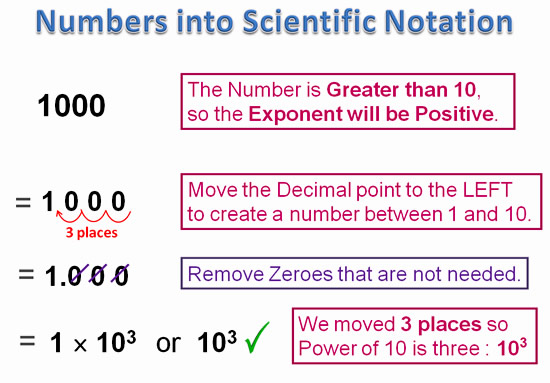
Image Copyright 2013 by Passy’s World of Mathematics
If we have a value which is between 1 and 10, then we can express it in Scientific Notation using the Power of Zero.
This is shown in the example below.
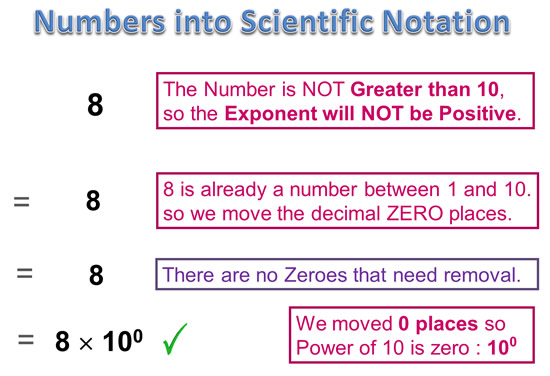
Image Copyright 2013 by Passy’s World of Mathematics
Scientific Notation on Calculators
There are usually special buttons on calculators for entering values that are in Scientific Notation format into the calculator.
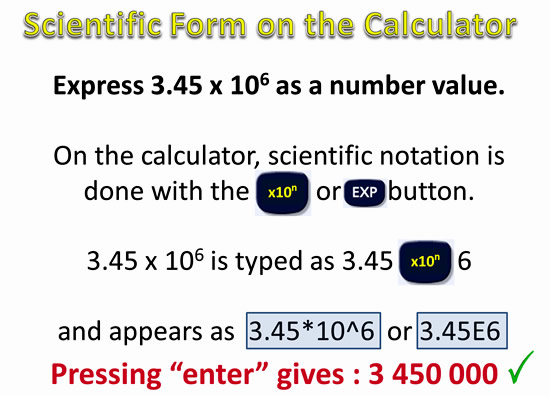
Image Copyright 2013 by Passy’s World of Mathematics
Related Items
Indices and Exponents in the Real World
Basic Indices and Exponents
Multiplying Exponents
Dividing Algebra Expressions
Dividing Exponents Using Subtraction Rule
Power of Power Exponents Rule
Expanding Exponent Products
Expanding Exponent Quotients
Zero and Negative Exponents
Subscribe
If you enjoyed this lesson, why not get a free subscription to our website.
You can then receive notifications of new pages directly to your email address.
Go to the subscribe area on the right hand sidebar, fill in your email address and then click the “Subscribe” button.
To find out exactly how free subscription works, click the following link:
If you would like to submit an idea for an article, or be a guest writer on our website, then please email us at the hotmail address shown in the right hand side bar of this page.
If you are a subscriber to Passy’s World of Mathematics, and would like to receive a free PowerPoint version of this lesson, that is 100% free to you as a Subscriber, then email us at the following address:
Please state in your email that you wish to obtain the free subscriber copy of the “Scientific Notation” Powerpoint.
Like Us on Facebook
Help Passy’s World Grow
Each day Passy’s World provides hundreds of people with mathematics lessons free of charge.
Help us to maintain this free service and keep it growing.
Donate any amount from $2 upwards through PayPal by clicking the PayPal image below. Thank you!
PayPal does accept Credit Cards, but you will have to supply an email address and password so that PayPal can create a PayPal account for you to process the transaction through. There will be no processing fee charged to you by this action, as PayPal deducts a fee from your donation before it reaches Passy’s World.
Enjoy,
Passy





Pingback: Significant Figures | Passy's World of Mathematics